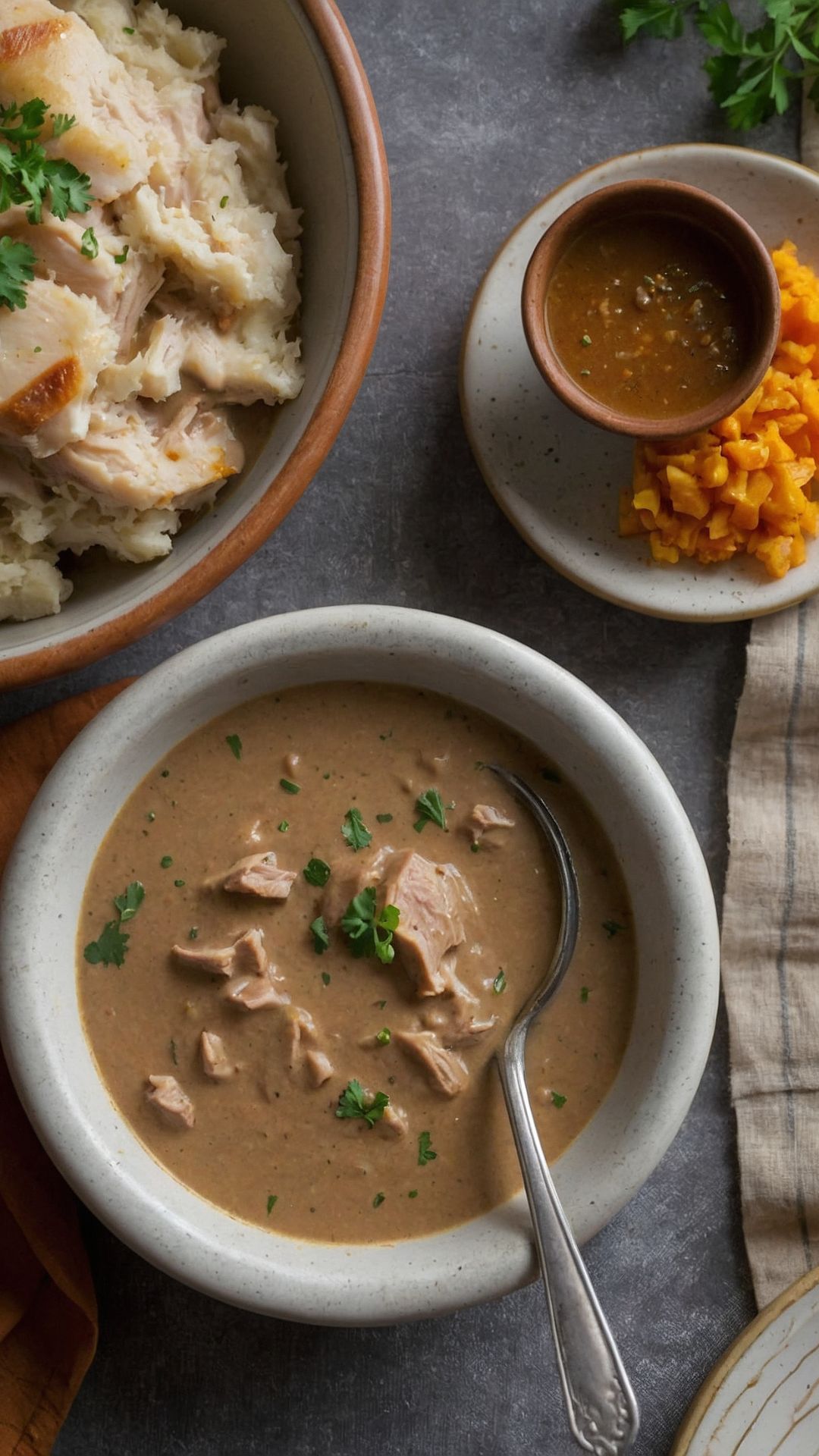Before we dive into the magic of homemade turkey gravy, let’s take a moment to consider what dishes complement this rich, flavorful sauce perfectly. Turkey gravy isn’t just a side dish; it enhances a variety of meals. Consider serving it with:
Mashed Potatoes: Creamy mashed potatoes and turkey gravy are a classic combo. The gravy seeps into the potatoes, creating a delightful blend of flavors that’s hard to resist.
Stuffing: Whether you prefer the classic bread stuffing or a wild rice concoction, gravy adds moisture and richness, harmonizing with the savory elements.
Roasted Vegetables: Drizzling gravy over a medley of roasted vegetables elevates them from simple sides to irresistible contributors on your plate.
Open-Faced Sandwiches: Think of sliced turkey on bread topped with gravy. It’s comfort food at its finest and can transcend generations.
Now that we have our pairings down, let’s get into the essence of what makes homemade turkey gravy both a staple and a delight at the dinner table.

Turkey gravy is that magical sauce that elevates a simple meal into something memorable. It’s rich, flavorful, and surprisingly simple to make.
Whether it’s slathered on mashed potatoes or served over turkey slices, gravy binds the meal together. I remember my first attempt at making gravy—a chaotic mix of flour, broth, and a bit too much enthusiasm. It didn’t turn out as I anticipated, but it sparked a passion for perfecting this culinary staple.
In this guide, we will unlock the secrets to creating homemade turkey gravy. You will learn why this recipe consistently delivers, what ingredients you need, step-by-step instructions, and some handy tips that will ensure your gravy is superb every time.
What is Homemade Turkey Gravy?
Homemade turkey gravy is a sauce made primarily from the drippings of roasted turkey, mixed with broth, fat, and a thickening agent like flour. It’s a staple in many kitchens, especially during holidays. It enhances the flavor of turkey, mashed potatoes, and stuffing, making every bite more delightful.
Why This Recipe Works
This gravy works because of its simplicity and adaptability. By using drippings from roasted turkey, you incorporate the bird’s flavors right into the sauce. If you don’t have drippings, substituting with quality broth keeps the flavor intact.
The balance of fat from the butter and the flour provides a silky texture. Moreover, a touch of Worcestershire sauce and seasoning enhances the complexity. Each ingredient has a role. The result? A luxurious, mouthwatering gravy that feels homemade—because it is!
You will also like the following Side Dishes recipes!
What You’ll Need to Make This Dish?
Here’s your shopping list so you can gather everything ahead of time:
Turkey Drippings: The flavorful essence of your turkey.
Low-Sodium Turkey or Chicken Broth: This will serve as your base.
Unsalted Butter: For richness.
All-Purpose Flour: Your thickener.
Worcestershire Sauce: To add depth.
Seasonings: A sprinkle of salt, pepper, and perhaps some herbs you enjoy.
This is your basic list. You can get creative later, but this skeleton will help build a robust gravy.

How to Make Homemade Turkey Gravy?
Homemade turkey gravy is surprisingly easy. The key is to allow the flavors to meld together beautifully. In the steps that follow, I will break down the process thoroughly.
Step 1: Collect the Drippings
After roasting your turkey, let it rest and collect those precious drippings from the pan. They are golden and packed with flavor—don’t let them go to waste! Pour the drippings into a measuring cup and let them settle. This will help separate the fat from the juices.
Step 2: Skim the Fat
Once the drippings have settled, you will notice a layer of fat on top. This is good! Use a spoon or a fat separator to skim it off. You’ll want to reserve some fat for the gravy while ensuring plenty of liquid remains. Aim for about ¼ cup of fat, balancing it with the good juices.
Step 3: Prepare the Roux
In a saucepan over medium heat, melt 3 tablespoons of unsalted butter along with an equal amount of the skimmed fat. Once bubbling, sprinkle in ¼ cup of all-purpose flour. Whisk continuously for about 2 minutes until it turns a light golden color. This roux is the backbone of your gravy, giving it body and thickness.
Step 4: Add the Broth
Gradually whisk in 3 cups of low-sodium turkey or chicken broth. Continue to whisk until the mixture thickens, usually taking 4-5 minutes. Adjust your heat as necessary, so you don’t burn the bottom.
Step 5: Season to Taste
Once your gravy has thickened, add in 1 teaspoon of Worcestershire sauce and season with salt, pepper, or any herbs you fancy. I often add a dash of fresh thyme or minced garlic for that cozy finish.
Step 6: Serve and Enjoy!
Your homemade turkey gravy is complete! It should be velvety and rich, perfect for pouring over your favorite Thanksgiving dishes or any comforting meal.
Tips
Creating the best homemade turkey gravy is often about the little details. Here are some tips to elevate your gravy-making game:
Use Quality Ingredients: Opt for a good quality broth and fresh herbs. They can make a world of difference.
Adjust Thickness: If your gravy is too thick, add more broth until you reach the desired consistency. If it’s too thin, allow it to simmer longer to reduce.
Strain for Smoothness: For a more refined texture, strain the gravy through a fine-mesh sieve to remove any lumps.
Make It Ahead: You can prepare your gravy ahead of time. Simply reheat it gently on the stove before serving and whisk in any extra broth to loosen.
Experiment with Flavors: Feel free to add in ingredients like garlic, herbs, or even a splash of wine for a different flavor profile.
How to Store Leftovers?
Leftover gravy is a treasure! Store it in an airtight container in the refrigerator for up to four days. Just make sure it cools down before sealing. If you want to keep it longer, it freezes beautifully. Pour it into freezer-safe containers and label them for up to three months. To reheat, simply thaw in the fridge and warm gently on the stove, adding a splash of broth to revive its silky texture.
Nutrition Information
Here’s a breakdown of nutrition for one serving (1/4 cup) of homemade turkey gravy made with drippings:
Calories: 60
Protein: 1.5g
Carbohydrates: 6g
Fat: 3.5g
Sodium: 200mg
These are approximate values and can vary based on specific ingredients used.
How Would I Recommend Serving Homemade Turkey Gravy?
Now, let’s talk about how to serve this delightful gravy:
On Mashed Potatoes: Create a luscious layer over creamy mashed potatoes. The smooth texture creates a velvety bite.
Over Stuffing: Drizzle over stuffing to moisten it up, making every forkful harmonious.
With Roast Turkey: Nothing beats a scoop of gravy flowing over sliced turkey. It complements the meat’s natural flavor.
With Biscuits: Serve it alongside flaky biscuits. The combination is unbeatable for breakfast or brunch.

What Alternatives Can You Use for the Ingredients If Not Available?
Sometimes, you might find yourself without the perfect ingredient for your gravy. Here are some substitutes to consider:
Broth: If you don’t have turkey broth, try chicken broth or even vegetable broth for a lighter taste.
Butter: In case you’re out of unsalted butter, olive oil can serve as a viable alternative. Just note that it changes the flavor slightly.
Flour: If you’re looking for a gluten-free option, use cornstarch mixed with cold water to thicken your gravy.
Worcestershire Sauce: If you don’t have this on hand, try soy sauce or a mix of vinegar and some simple spices as a substitute to achieve that umami flavor.

Equipment
- Saucepan
- Whisk
Ingredients
- Turkey Drippings: The flavorful essence of your turkey.
- Low-Sodium Turkey or Chicken Broth: This will serve as your base.
- Unsalted Butter: For richness.
- All-Purpose Flour: Your thickener.
- Worcestershire Sauce: To add depth.
- Seasonings: A sprinkle of salt pepper, and perhaps some herbs you enjoy.
Instructions
Step 1: Collect the Drippings
- After roasting your turkey, let it rest and collect those precious drippings from the pan. They are golden and packed with flavor—don’t let them go to waste! Pour the drippings into a measuring cup and let them settle. This will help separate the fat from the juices.
Step 2: Skim the Fat
- Once the drippings have settled, you will notice a layer of fat on top. This is good! Use a spoon or a fat separator to skim it off. You’ll want to reserve some fat for the gravy while ensuring plenty of liquid remains. Aim for about ¼ cup of fat, balancing it with the good juices.
Step 3: Prepare the Roux
- In a saucepan over medium heat, melt 3 tablespoons of unsalted butter along with an equal amount of the skimmed fat. Once bubbling, sprinkle in ¼ cup of all-purpose flour. Whisk continuously for about 2 minutes until it turns a light golden color. This roux is the backbone of your gravy, giving it body and thickness.
Step 4: Add the Broth
- Gradually whisk in 3 cups of low-sodium turkey or chicken broth. Continue to whisk until the mixture thickens, usually taking 4-5 minutes. Adjust your heat as necessary, so you don’t burn the bottom.
Step 5: Season to Taste
- Once your gravy has thickened, add in 1 teaspoon of Worcestershire sauce and season with salt, pepper, or any herbs you fancy. I often add a dash of fresh thyme or minced garlic for that cozy finish.
Step 6: Serve and Enjoy!
- Your homemade turkey gravy is complete! It should be velvety and rich, perfect for pouring over your favorite Thanksgiving dishes or any comforting meal.
Notes
- Use Quality Ingredients: Opt for a good quality broth and fresh herbs. They can make a world of difference.
- Adjust Thickness: If your gravy is too thick, add more broth until you reach the desired consistency. If it’s too thin, allow it to simmer longer to reduce.
- Strain for Smoothness: For a more refined texture, strain the gravy through a fine-mesh sieve to remove any lumps.
- Make It Ahead: You can prepare your gravy ahead of time. Simply reheat it gently on the stove before serving and whisk in any extra broth to loosen.
- Experiment with Flavors: Feel free to add in ingredients like garlic, herbs, or even a splash of wine for a different flavor profile.
Nutrition
Frequently Asked Questions
1. Can I make gravy without drippings?
Absolutely! Use a combination of broth and butter for a flavorful alternative. You might want to add in some sautéed vegetables for depth.
2. How do I fix grainy gravy?
If your gravy turns out grainy, try straining it through a fine mesh sieve to remove lumps.
3. Can I make turkey gravy ahead of time?
Yes! You can prepare it up to three days in advance. Just reheat gently on the stove, adding broth if necessary to loosen.
4. How do I thicken turkey gravy without flour?
Using cornstarch is a great alternate thickener. Mix cornstarch with cold water and add it to simmering gravy.
5. Is homemade gravy better than store-bought?
Many agree homemade gravy tastes superior. It allows better control over flavors and quality.
6. Can I add herbs for flavor?
Yes! Fresh herbs like thyme, rosemary, or sage can amplify the taste, making it even more delightful.
Conclusion
Homemade turkey gravy is not just a side dish—it’s a celebration of flavors, aromas, and the memories they evoke. Whether it’s draped over mashed potatoes or served as an essential part of a family feast, making your own gravy opens a door to culinary creativity. With simple ingredients and straightforward steps, it’s a worthwhile endeavor that brings joy to the table. So roll up your sleeves, gather your ingredients, and dive into the delicious world of homemade turkey gravy. You’ll be glad you did!
You’ll also like these latest recipes!

Rebecca Novak is a trained chef with over 10 years of experience in the food industry. She has worked in both fine dining and casual Hungarian restaurants and specializes in creating dishes using fresh, seasonal ingredients. She also loves exploring different cuisines worldwide, which allows her to bring unique flavors and ideas to the recipes she creates for Hungarianchef.com. Read more
